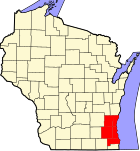Waubeka, Wisconsin
Inhabited by Native Americans into the mid-1800s, Waubeka was named for a Potawatomi chief who was friendly with the first white settlers who arrived in the area in the 1840s. Waubeka was the site of the first formal observance of Flag Day in 1885, and today the community is home to the National Flag Day Foundation's Americanism Center, which serves as the organization's headquarters and contains a museum.
History
The land that became the Waubeka was originally inhabited by Native Americans, including the Potawatomi tribe, who surrendered the land to the United States government in the 1833 Treaty of Chicago. While many people moved west of the Mississippi River to Kansas, a few chose to remain, and were referred to as "strolling Potawatomi" in contemporary documents because many of them were migrants who subsisted by squatting on their former lands, now owned by White settlers. One such group was led by Chief Waubeka, who maintained a winter camp on the south bank of the Milwaukee River in present-day Waubeka as late as 1845. The chief's wigwam was located near the present site of the Gerald Joose house. In the Potawatomi language, "Waubeka" means "metal." Eventually the Potawatomi gathered in northern Wisconsin, where they formed the Forest County Potawatomi Community.
In the 1840s, Waubeka was the largest settlement in the Town of Fredonia. The first European civilization was from settlers who were English, Irish, Scottish, and Yankees from the East Coast. In 1848, a group of German immigrants arrived from Prussia and settled in the northern part of Waubeka. Luxemburger and Belgian newcomers settled in eastern Waubeka, and others from Bavaria and Saxony settled in the northwest.
Geography
Waubeka is 840 feet (256 m) above sea level and is located at 43°28′30″N 87°59′25″W / 43.47500°N 87.99028°W (43.4749994, -87.9903696). According to the United States Census Bureau, the community has a total area of 2.416 square miles (6.26 km): 2.343 square miles (6.07 km) land and 0.073 square miles (0.19 km) water. Waubeka is located in the Town of Fredonia, and borders to the Village of Fredonia to the east and the Town of Saukville to the south.
The community is located in the Southeastern Wisconsin glacial till plains that were created by the Wisconsin glaciation during the most recent ice age. The area has some subterranean Silurian limestone formations that are part of the Racine Dolomite that stretches through eastern Wisconsin and Illinois.
Before Europeans arrived in and civilized the area, the Waubeka area was an upland forest dominated by American beech and sugar maple trees. There were also white cedars growing along the Milwaukee River, which flows along the community and provided a power source for the community's early industries. Much of the original forest was cleared to prepare the land for agriculture.
Large mammals, including white-tailed deer, coyotes, North American river otters and red foxes can be seen in the village. Many birds, including great blue herons and wild turkeys are found in the community.
The region struggles with many invasive species, including the emerald ash borer, common carp, reed canary grass, the common reed, purple loosestrife, garlic mustard, Eurasian buckthorns, and honeysuckles.
Flag Day

United States Flag Day was first formally observed in Waubeka. On June 14, 1885, Stony Hill School teacher and Waubeka-native Bernard J. Cigrand instructed his students to write essays about what the flag of the United States meant to them to commemorate the Continental Congress's 1777 adoption of the flag as a national symbol. It was the first formal observance of Flag Day.
In 1995, the National Flag Day Foundation constructed the Americanism Center in Waubeka. A 13,000-square-foot facility on fifteen acres of land, the center serves as the foundation's headquarters and also houses a museum with an extensive collection of patriotic memorabilia, military uniforms, and artifacts from the life of Bernard J. Cigrand. The foundation organizes a parade in Waubeka each Flag Day.
Notable residents
- Bernard J. Cigrand, founder of Flag Day in the United States, was born in Waubeka.
References
- ^ "2018 U.S. Gazetteer Files". United States Census Bureau. Retrieved February 15, 2020.
- ^ "US Board on Geographic Names". United States Geological Survey. October 25, 2007. Retrieved January 31, 2008.
- ^ "U.S. Census website". U.S. Census Bureau. Retrieved April 20, 2011.
- ^ "Village of Bayside: History". Village of Bayside. Retrieved January 10, 2020.
- ^ "Newland Became Cedarburg". The Milwaukee Sentinel. September 4, 1967. pp. Part 5, Page 5. Retrieved April 23, 2015.
- ^ "Potawatomi History". Milwaukee Public Museum. Retrieved February 20, 2020.
- ^ "Early history of Ozaukee County, Wisconsin". University of Wisconsin-Madison Libraries. Retrieved January 3, 2020.
- ^ U.S. Geological Survey Geographic Names Information System: Waubeka, Wisconsin
- ^ "Inventory of Agricultural, Natural, and Cultural Resources". Ozaukee County. Retrieved January 20, 2020.
- ^ "Ecological Landscapes of Wisconsin" (PDF). Wisconsin Department of Natural Resources. Retrieved February 13, 2020.
- ^ "History". National Flag Day Foundatation. Retrieved May 18, 2020.
- ^ "National Flag Day Foundation". National Flag Day Foundation. Retrieved May 18, 2020.
- ^ "National Flag Day Foundation - B. J. CiGrand". www.nationalflagday.com.
External links
- Fredonia & Waubeka Area
- Waubeka Volunteer Fire Department
- Sanborn fire insurance map: 1910

